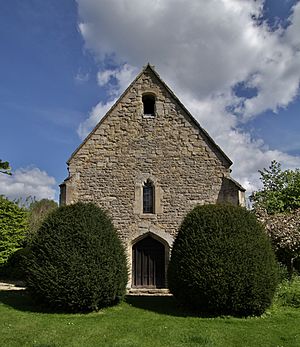St Bartholomew's Chapel, Oxford facts for kids
Quick facts for kids St Bartholomew's Chapel |
|
|---|---|

West front of the chapel
|
|
| 51°44′43″N 1°13′36.66″W / 51.74528°N 1.2268500°W | |
| Location | Oxford |
| Country | England |
| Denomination | Church of England |
| History | |
| Authorising papal bull | 1194 |
| Status | Chapel |
| Founded | 12th century Irestored = 1329 |
| Founder(s) | Henry I |
| Dedication | Bartholomew the Apostle |
| Architecture | |
| Heritage designation | Grade I |
| Designated | 12 January 1954 |
| Administration | |
| Diocese | Oxford |
| Province | Canterbury |
St Bartholomew's Chapel, also known as Bartlemas Chapel, is a small chapel in Oxford, England. It was built in the early 1300s. The chapel was part of a hospital for people with leprosy, a serious skin disease.
King Henry I started the hospital in the early 1100s. It was meant for twelve sick people and a chaplain. Later, in 1328, King Edward III gave the hospital to Oriel College. During the English Civil War, the chapel and other hospital buildings were damaged.
Today, a special evening service called evensong is held here. It happens on the last Sunday of most months.
Contents
History of Bartlemas Chapel
King Henry I supported the hospital with money and supplies. Records from 1129 show the hospital was already active. Later kings, like King Stephen and Henry II, also supported it. In 1162, money was spent on building for the sick in Oxford.
In 1194, Pope Celestine III confirmed the hospital's rights. In 1238, Pope Gregory IX said they didn't have to pay certain taxes. During the 1200s, the hospital received small gifts. Around 1330, its land brought in about £7 a year.
Challenges for the Hospital
In the early 1300s, some leaders of the hospital caused problems. One leader, Adam de Weston, was appointed in 1312. People said he sold farm goods and kept the money. They also said he fired the chaplain, so church services rarely happened. He also dismissed farm workers and treated a former leader badly.
Because of these issues, Adam de Weston lost his job. Peter de Luffenham took over in 1315. But the sick people complained about him too. They said he took too much money and didn't care for them.
In 1316, King Edward II changed the rules. He said only eight sick people could live there, not twelve. He also set how much money each person would get. The master, who was also the chaplain, would get £4 a year. In 1321, the King allowed a healthy person to join. This person promised to pay for chapel roof repairs.
By 1325, the hospital was falling apart. The leader, Robert de Sutton, was blamed. So, in 1326, the job of leading the hospital was given to the head of Oriel College, Adam de Brome.
Oriel College Takes Over
In 1328, King Edward III made new plans for the hospital. He gave it to Oriel College. The college had to pay the sick people and have a chaplain. Any extra money would go to Oriel College. The hospital also became a place for sick college members to get better.
In 1367, the college complained that the sick people were not obeying rules. The King then added more rules. For example, married people or those in debt could not join. If someone joined, they had to give all their belongings to the hospital. They also couldn't make a will. The sick people also had to live simply. They could not leave the hospital without their special clothes. They also couldn't invite friends without permission.
In 1390, another person tried to take over the hospital. But Oriel College fought this decision. The court decided that the hospital belonged to the college.
The Chapel Building
The chapel has its main hall (the nave) and the altar area (the chancel) in one long room. The north doorway, with its curved stone arch, is very old. Changes were made to the west doorway and the roof in the 1400s. These changes were in a style called Perpendicular Gothic. The roof has a decorative edge that looks like castle walls.
The large windows have interesting patterns. They are from the 1300s, but some parts might have been added in the 1600s. One of the west windows is from the 1600s. Repairs to the hospital were recorded in 1600, 1635, and 1649. The last repair was for damage during the English Civil War. You can still see parts of two painted crosses on the west wall.
Inside, there is a simple wooden screen from 1651. Oriel College gave this screen to the chapel. The plain wooden benches and other fittings were designed by Ninian Comper. St Bartholomew's Chapel is a very important historic building. It is listed as a Grade I listed building.
Myths and Traditions
The chapel used to have some special items, called relics. These included a comb said to belong to Edward the Confessor, which people believed could cure headaches. There was also a piece of skin from St Bartholomew himself. And bones from St Andrew and St Philip were also kept there.
A special tradition used to happen on May Day and Ascension Day. Students and singers from New College would walk in a procession to the chapel. They would say prayers and sing hymns. Then, near a well, after some religious readings, they would have fun with "woodland merriment." This was a kind of old-fashioned, joyful celebration. After that, they would go back to their college.
This tradition was brought back on May 21, 2009. The singers from New College performed a special ceremony at Bartlemas Chapel. Afterward, they went to Oriel College's playing field. There, they sang old songs called madrigals around where the ancient spring used to be.


